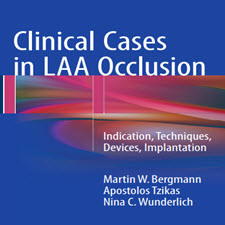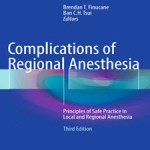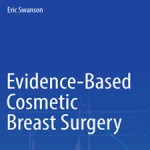Clinical Cases in LAA Occlusion
ABSTRACT
When starting or expanding a LAA closure program, the imminent question certainly raised by referring physicians, and possibly even by some patients, is: why go for a potentially risky cardiac intervention if a well proven drug therapy like NOAC is available? Many patients prefer a single 2–3 days hospital stay with a low risk cardiac intervention similar to pulmonary vein isolation or PFO closure, over a long-term therapy which increases sensitivity to skin bruises, gastro-intestinal bleeding and other side effects. Non-interventional general practitioners or other colleagues not close to the feld may argue that evidence is not suffcient as the number of patients included in prospective trials is low and only available for the Watchman device. Randomized trials and prospective registries in over 500,000 patients treated with NOAC’s are available. In the absence of a randomized trial comparing NOAC therapy to LAA closure, in-depth discussion of the available data is necessary to achieve consensus. This chapter focusses on a critical appraisal of NOAC study data and provides a simple algorithm incorporating both US and European guidelines regarding indication for LAA closure.
INTRODUCTION
Atrial fbrillation (AF), regardless if paroxysmal, persistent, long-standing persistent or permanent, confers a fve-fold risk of stroke overall 5 times higher than in patients without atrial fbrillation. Individual risk is calculated on the basis of the CHA2DS2–VASc score with a score ≥1 indicating the need for oral anticoagulation; this means that, aside from younger (<65 years) patients without cardiovascular risk factors, all patients with AF should receive a therapeutic measure for stroke prevention. CHA2DS2–VASc score calculators are available in many smartphone APP’s and should be documented in every AF patient. From a European perspective, CHADS2 is no longer in use. Patients with lone atrial fbrillation are often symptomatic even on one or more drugs meant for rhythm control. These patients will likely be eligible for pulmonary vein isolation (PVI) . However, according to the guidelines and published data, the indication for oral anticoagulation even after PVI is strictly linked to the CHA2DS2–VASc score as the current interpretation of the effect of PVI in most patients is to convert symptomatic AF to asymptomatic AF. Whereas PVI reduces the burden of AF more effciently than available drug therapies (i.e. from 3.6 to 0.3 h per day in one study), only 21% of patients were completely free of any AF episode during a follow up of 41.4 ± 15.1 months employing an implantable monitoring device.
چکیده
هنگام شروع یا گسترش یک برنامه بسته شدن LAA، سوال اصلی که با اشاره به پزشکان و احتمالا حتی برخی از بیماران مطرح می شود، این است: چرا برای مداخله ای که احتمالا خطرناک قلبی است، اگر یک درمان معتبر دارویی مانند NOAC در دسترس باشد؟ بسیاری از بیماران ترجیح می دهند یک 2-3 روز اقامت در بیمارستان را با مداخلات قلبی کم خطر مشابه انزال ورید ریوی و یا PFO بسته شدن، در طول درمان طولانی مدت است که باعث افزایش حساسیت به کبودی پوست، خونریزی های روده ای و سایر عوارض جانبی می شود. پزشکان غیر مداخله ای و یا همکاران دیگر که در نزدیکی فلو قرار نگرفته اند ممکن است استدلال کنند که این شواهد به دلیل عدم وجود تعداد بیماران در آزمایش های آینده نگر کم و تنها برای دستگاه Watchman قابل استفاده است. آزمایشات تصادفی و ثبت نام های آینده در بیش از 500،000 بیمار تحت درمان با NOAC موجود است. در غیاب یک کارآزمايی تصادفی با مقایسه NOAC درمانی با بستن LAA، بررسی جامع داده های موجود برای دستیابی به اجماع ضروری است. این فصل بر روی ارزیابی انتقادی از داده های مطالعه NOAC تمرکز می کند و یک الگوریتم ساده که شامل دستورالعمل های ایالات متحده و اروپا در مورد نشانه ای برای بسته شدن LAA است را فراهم می کند.
مقدمه
فیبروز دهلیزی (AF)، صرفنظر از اینکه پره اکسیامال، مداوم، طولانی مدت دائمی یا دائمی، خطر کلیه سکته مغزی را 5 برابر بیشتر از بیماران بدون تصادف دهلیزی می دهد. ریسک فردی براساس نمره CHA2DS2-VASc با نمره ≥1 نشان دهنده نیاز به ضد انعقادی دهانی است؛ این بدان معنی است که، به استثنای افراد زیر سن 65 سال و بدون فاکتورهای خطر قلبی عروقی، تمام بیماران مبتلا به AF باید اقدامات درمانی برای پیشگیری از سکته را دریافت کنند. ماشین حساب نمره CHA2DS2-VASc در بسیاری از APP های گوشی های هوشمند در دسترس است و باید در هر بیمار AF ثبت شود. از منظر اروپایی، CHADS2 دیگر در حال استفاده نیست. بیماران مبتلا به فیبروز دهلیزی تنها اغلب علامت حتی در یک یا چند دارو برای کنترل ریتم هستند. این بیماران احتمالا واجد شرایط برای انزوای رگهای ریوی (PVI) خواهند بود. با این حال، با توجه به دستورالعمل ها و داده های منتشر شده، نشانه ای از ضد انعقاد دهان حتی پس از PVI به شدت با نمره CHA2DS2-VASc مرتبط است، به عنوان تفسیر فعلی اثر PVI در اکثر بیماران، تبدیل AF علائم به AF بدون علامت است. در حالی که PVI بار AF را بیشتر از داروهای موجود در دسترس (یعنی از 3.6 تا 0.3 ساعت در روز در یک مطالعه کاهش می دهد)، تنها 21٪ از بیماران در طی یک پیگیری از 15.1 ± 41.4 ماه به طور کامل از هر بخش AF استفاده می کردند دستگاه نظارت بر ایمنی.
Year: 2016
Publisher: SPRINGER
By : Martin W. Bergmann , Apostolos Tzikas, Nina C. Wunderlich
File Information: English Language/ 168 Page / size: 13.50 MB
Only site members can download free of charge after registering and adding to the cart
سال : 1395
ناشر : SPRINGER
کاری از : مارتین وار Bergmann، Apostolos Tzikas، نینا C. Wunderlich
اطلاعات فایل : زبان انگلیسی / 168 صفحه / حجم : MB 13.50
[sdfile url =”http://dl.taliem.ir/book/pezeshki/Clinical.Cases.in.LAA.Occlusion.Indication-taliem.ir.rar”]



![Urolithiasis.in.Clinical.Practice.[taliem.ir] Urolithiasis.in.Clinical.Practice.[taliem.ir]](https://taliem.ir/wp-content/uploads/Urolithiasis.in_.Clinical.Practice.taliem.ir_.jpg)
![Chest.Drains.in.Daily.[taliem.ir] Chest.Drains.in.Daily.[taliem.ir]](https://taliem.ir/wp-content/uploads/Chest.Drains.in_.Daily_.taliem.ir_.jpg)
![Clinical Management of[taliem.ir] Clinical Management of[taliem.ir]](https://taliem.ir/wp-content/uploads/Clinical-Management-oftaliem.ir_.jpg)
![Emergency Clinical..[taliem.ir] Emergency Clinical..[taliem.ir]](https://taliem.ir/wp-content/uploads/Emergency-Clinical..taliem.ir_.jpg)
![Textbook.of.Clinical.Sexual.Medicine.[taliem.ir] Textbook.of.Clinical.Sexual.Medicine.[taliem.ir]](https://taliem.ir/wp-content/uploads/Textbook.of_.Clinical.Sexual.Medicine.taliem.ir_.jpg)
![Seizures.in.Critical.Care.A.Guide.to.Diagnosis.[taliem.ir] Seizures.in.Critical.Care.A.Guide.to.Diagnosis.[taliem.ir]](https://taliem.ir/wp-content/uploads/Seizures.in_.Critical.Care_.A.Guide_.to_.Diagnosis.taliem.ir_.jpg)
![Dialysis.Access.Cases.Practical.Solutions.[taliem.ir] Dialysis.Access.Cases.Practical.Solutions.[taliem.ir]](https://taliem.ir/wp-content/uploads/Dialysis.Access.Cases_.Practical.Solutions.taliem.ir_-1.jpg)
![Clinical Core Laboratory[taliem.ir] Clinical Core Laboratory[taliem.ir]](https://taliem.ir/wp-content/uploads/Clinical-Core-Laboratorytaliem.ir_.jpg)


دیدگاه خود را ثبت کنید
تمایل دارید در گفتگو شرکت کنید؟نظری بدهید!